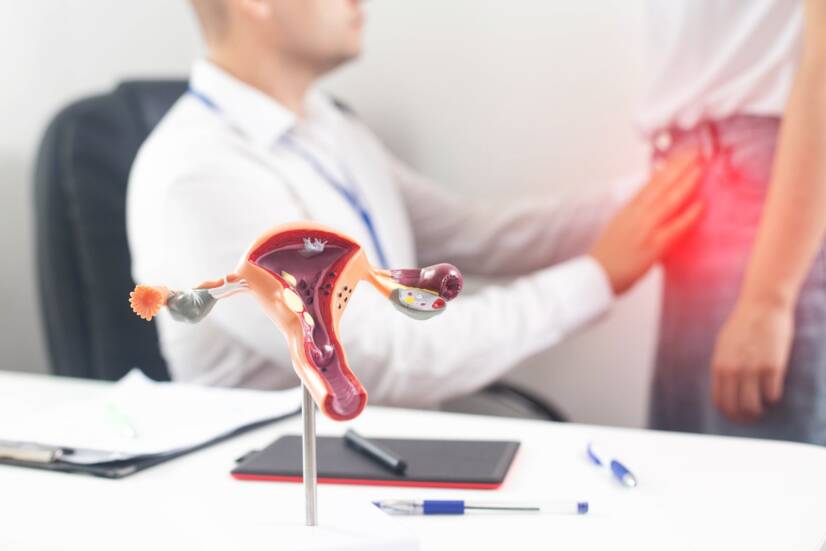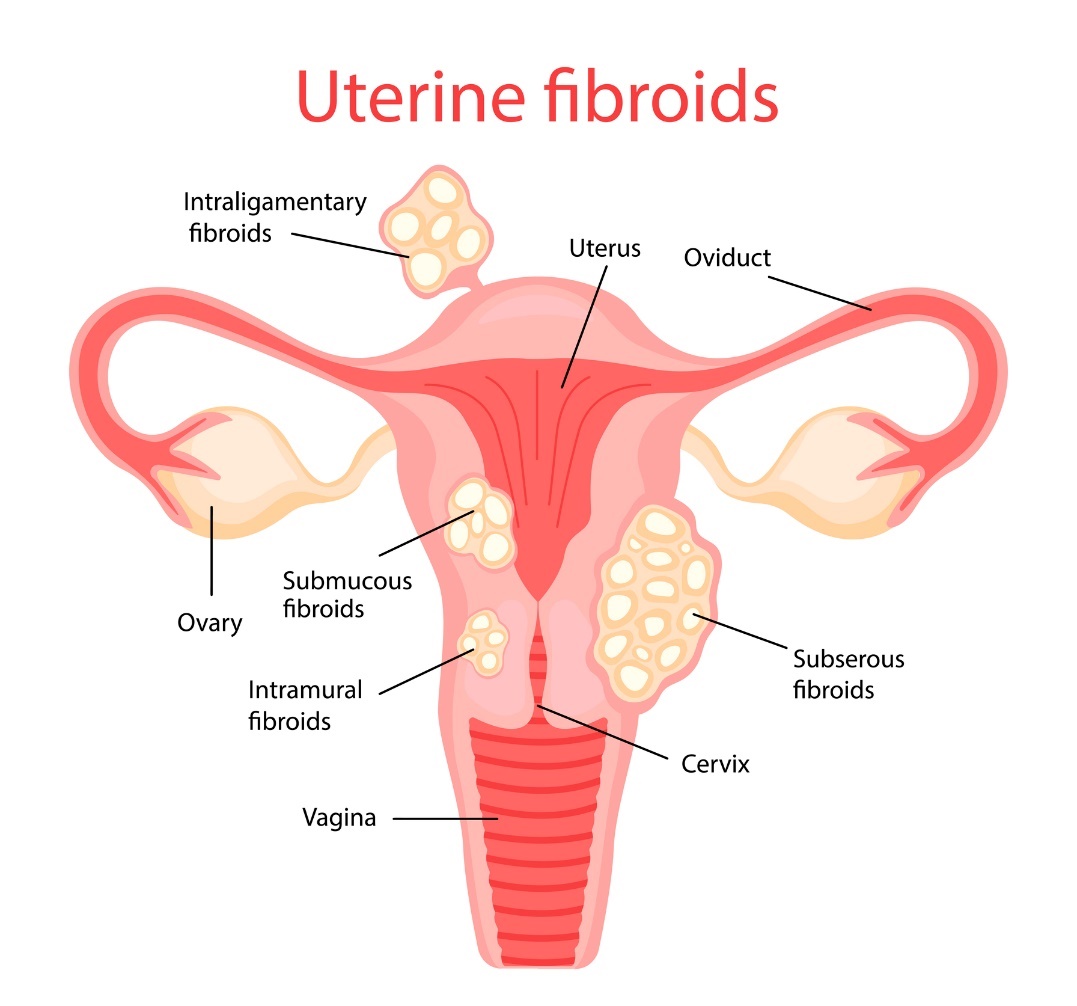- pubmed.ncbi.nlm.nih.gov - Uterine fibroids: diagnosis and treatment. Maria Syl D De La Cruz, Edward M Buchanan
- DUBOVÁ, Olga and Michal ZIKÁN. Practical Repetitorium of Gynaecology and Obstetrics. 2nd edition. 2nd edition: Maxdorf, [2022]. Jessenius Medical Faculty of Charles University in Prague. ISBN 978-80-7345-716-7
- jogc.com - Treatment of uterine leiomyomas. Sogc Clinical Practice Guideline
- ROZTOČIL, Aleš and Pavel BARTOŠ. Modern Gynaecology. Prague: Institute of Gynaecology and Obstetrics of the CAS, v. v. i. Grada, 2011. ISBN 978-80-247-2832-2.
- solen.cz - Uterine smooth muscle tumours with uncertain malignant potential. Monika Náležinská, Petr Škapa, Jiří Špaček, Josef Chovanec.
Myoma of the uterus: cause, symptoms. Is it dangerous for a woman?

Uterine fibroids are the most common benign tumor of the uterine musculature in women. What is it and how does it manifest itself? Can it be dangerous?
Most common symptoms
- Period pain
- Lower Abdominal Pain
- Constipation
- Flatulence - bloating
- Menstrual cycle disorders
- Long menstrual bleeding
Characteristics
Furthermore, the article offers interesting information on prevention and to what extent it is dangerous for a woman in general and with regard to fertility and pregnancy.
The anatomy of the uterus in a nutshell
The internal organs of the female reproductive system include the uterus (uterus), ovaries, fallopian tubes and vaginal tube.
The uterus is a hollow muscular organ located in the middle of the small pelvis. It is attached by a ligamentous suspensory apparatus. It consists of two main parts, namely the cervix and the actual body (cavity) of the uterus.
Histologically, the uterus consists of 3 layers.
1. The innermost is the uterine lining (endometrium).
2. The middle layer is the uterine musculature (myometrium).
3. The top layer is the peritoneal envelope (perimetrium).
Uterine fibroids originate and grow in the middle muscular layer of the myometrium. This is the origin of the name benign neoplasm.
Uterine myoma
A uterine fibroid is also technically called a fibroid or leiomyoma. It is a benign benign growth arising from the uterine musculature.
A myoma is caused by the growth of abnormal cells, but it is not cancer. Thus, it does not metastasize.
Approximately half of women aged 35-50 years will develop a fibroid during their lifetime.
Genetics, hormonal imbalance and advancing age are the main factors in the development of fibroids. However, they occur mainly in premenopausal women.
The size of fibroids varies and ranges from approximately 1 cm to 15 cm. Untreated fibroids can increase the size of the uterus itself.
They are usually located in the muscle of the uterine cavity, but can also occur in the wall of the fallopian tube, ovary or cervix.
According to the localization, uterine fibroids are divided into:
- Submucosal: located under the uterine mucosa, they can protrude through the mucosa and into the uterine cavity.
- Intramucosal: they are located directly in the muscular wall of the uterus and do not penetrate into the surrounding layers.
- Subserous: located on the outer side of the uterine wall, they can grow into the abdominal/pelvic cavity.
- Stalked: located and growing on a stalk towards the abdominal cavity, uterine cavity, cervix or vaginal canal.

Causes
The cause of fibroid formation is multifactorial.
First of all, it is race, genetic factor and susceptibility, advanced age and hormonal changes or imbalance in the woman's body.
It is scientifically confirmed that both sex hormones (estrogen and progesterone) act as potential promoters of the growth of unicellular fibroids.
Estrogen receptors tend to be present in the tissue of fibroids and bind a higher percentage of the hormone estradiol.
A link between fibroid formation and growth stimulation by sex or growth hormones has also been demonstrated.
Possible factors in the formation of uterine fibroids:
- Age before menopause
- Genetic factor
- Hormonal imbalance
- Hormonal contraception
- Estrogen receptor disorder
- Hormonal treatment
- Growth hormone stimulation
- Frequent pelvic inflammatory disease
- Obesity
- Early onset of menarche (first menstrual period)
- Pregnancy and childbirth
- High blood pressure
- Alcohol and tobacco intake
- Excessive caffeine intake
Symptoms
In many cases, a small fibroid is asymptomatic.
However, specialist diagnosis by a gynaecologist and regular follow-up are necessary.
The most common manifestation of uterine fibroids is a change in the menstrual cycle. This mainly involves heavier or prolonged bleeding, painful menstruation and pressure (pain) in the lower abdomen.
There may also be light bleeding outside the cycle, pain with intercourse, problems with bowel movements or problems getting pregnant.
In addition to regular preventive check-ups, a woman should see her gynaecologist immediately if she develops unusual symptoms and pain.
The most common manifestations of uterine fibroids:
- Heavy menstrual bleeding
- Weak bleeding outside the cycle
- Painful menstruation
- Pain in the lower abdomen
- Pain in the pelvic area
- Increased pressure in the lower abdomen
- Swelling in the abdominal area
- Anaemia and anaemic syndrome
- Pain during sexual intercourse
- Pressure on the bladder
- Constipation and excessive flatulence
- Problems with getting pregnant
Diagnostics
The gynecologist uses an external abdominal ultrasonograph and an internal ultrasonograph through the vaginal entrance on a monitor screen to examine the internal structures of the patient's uterus.
The easy availability of ultrasound allows immediate diagnosis of almost all types of fibroids.
The gynaecologist can refer the patient for an MRI (magnetic resonance imaging) or CT (computed tomography) scan to better image the soft internal structures and locate uterine muscle growths.
In some cases, a hysteroscopy is recommended for the patient.
Prevention of uterine fibroids
There is no prevention of uterine fibroid growth per se. However, it is possible to target risk factors that could potentially cause uterine fibroids.
These include a healthy lifestyle in terms of an appropriate wholesome diet, sufficient exercise, intake of necessary vitamins (B, D, E) and minerals, limiting alcohol, tobacco and caffeine consumption and eliminating muscle imbalances in the pelvic area.
Maintaining hormonal balance in the body and treating other associated medical diagnoses under the supervision of a specialist is recommended.
For the health of the female genital organs, the use of the beneficial effect of herbs is advisable in terms of natural help. These are mainly the common yarrow, yarrow, drumstick or blackberry and many others.
However, it is advisable to consult a gynaecologist when consuming them, as they can individually affect the levels of certain sex hormones.
Uterine fibroids and pregnancy
The problematic nature of a fibroid during pregnancy depends on its size, nature and exact localization.
If the uterine fibroid is small, not risky and does not form an obstacle to vaginal delivery, its growth can only be monitored periodically. Thus, it does not cause any health risks.
On the other hand, if the fibroid is causing the woman bleeding, pain, pressure or other health problems, it is advisable to remove it before pregnancy. Therefore, regular preventive examinations and early diagnosis and treatment of uterine fibroids are necessary.
If a growth in the uterus causes health problems during an ongoing pregnancy, the condition of the fibroid should be monitored regularly and addressed individually with a gynaecologist.
Uterine fibroids and female fertility
Fibroids can affect a woman's fertility by several mechanisms: deformation of the uterine cavity, irregular growth, changes in sensitivity and blood supply to the endometrium (uterine lining) or local hormonal changes.
All of these aspects can in some way reduce a woman's fertility and lead to infertility.
Therefore, accurate diagnosis of fibroids and determination of their risk is necessary.
Fertility = fertility, ability to reproduce.
Some high-risk fibroids can adversely affect the course of pregnancy and the delivery itself. A possible association of fibroids with a higher risk of preterm birth has also been described. Early diagnosis and the introduction of specialised treatment are therefore essential.
In addition to the nature of the fibroid itself, its location also plays an important role. If the growth is smaller but pushes inside the uterine cavity, it may be intrusive.
Conversely, a larger fibroid growing outside the uterus may not cause any difficulty. Each fibroid is individual and a specialist diagnostic examination is necessary.
How it is treated: Uterine myoma
Treatment of uterine fibroids: drugs, hormones, surgery, laparoscopy
Show moreUterine myoma is treated by
Other names
Interesting resources










